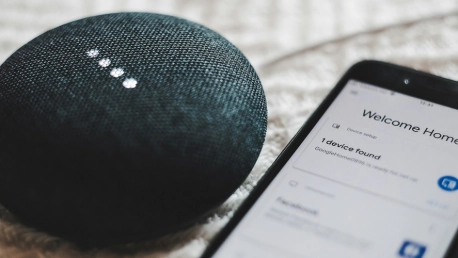The smart home market worldwide is calculated to turn a profit of 154.4 billion USD in 2024, according to Statista. Houses are evolving, appliances are starting to think, and our lives are more enjoyable.
When you leave your office, you can send instructions to your home from your phone or the car and start the vacuum. Or the dryer. Or the air purifier. At the gate, your lock will recognize your biometrics and let you in. When you enter your living room, your favorite playlist will start. Your smart speaker system knows you like to wind down to “Teardrop” by Massive Attack.
Everywhere you look—touch screens, or forget touch screens, even, because voice command is the future. But whatever you choose, your home will be smarter than you. So, let’s see the latest upgrades to smart homes in 2024.
Multifunctional Tech
As we enter 2024, we already see a surge in multifunctional tech. Here is a list of the most prominent hybrids that can make your home smarter:
1. LG PuriCare™ AeroFurniture
LG has created a new multifaceted piece of technology called the LG PuriCare Objet Collection Aero Furniture, implying it will not be the last piece of furniture we see in this series. For now, you can enjoy an air purifier, wireless charger, and mood lighting — all in the shape of an end table.
And if those aren’t enough functions for you, there are also eight preset mood lighting options to choose from. The price comes with an initial shock, but when you combine the values of each of these features, it seems reasonable for a new product. As futuristic design continues to manifest in our homes, we can expect multifunctional tech to become more affordable as well as stylistically diverse.
2. Novabot
Novabot is a smart lawn mowing robot with a security camera that features. This smart yard machine uses wire-free technology to customize cutting options and follow a route its owners create, including invisible boundaries. People who like mowing lawns on their Husqvarna 214TC have serious competition—one with a long battery life and can independently avoid obstacles. It can also cut grass at a 45-degree angle. Lawns of the future look greener than ever with robots quietly landscaping, all the while minimizing CO2 emissions.
3. Airbot Z1
Airbot Z1 serves as an air purifier and as a portable speaker. By its elegant design, you wouldn’t expect either. It follows you around the house like R2D2, moves and refreshes the air, plays music, and looks like a vacuum that can serve up a shot of espresso. Powered by AI, it enters and maps rooms effortlessly, avoiding obstacles with the latest in mapping navigation.
4. Smart Mirrors
Smart mirrors combine beauty and fun by boasting an electronic display and their usual shiny, reflective surface. The display can be basic or as advanced as money can buy, from showcasing widgets such as weather updates and news alerts to playing your favorite show on Netflix. Despite the steep prices, the market size of smart mirrors is expected to reach USD 5.9 billion in 2027, with a profit margin already surpassing 2.7 billion.
Besides popular streaming services and social media apps, smart mirrors come with a handy option to sanitize your bathroom. The UVC Mirror incorporates UV lighting into its sleek design and can sanitize your sink, faucet, and utensils. Now, that is a feature worth paying an extra buck for.
Energy Efficient Living
Efficient homes are not just becoming more popular as homeowners want to reduce electric bills. They are essential for the global rush against time to reduce greenhouse effects and increase sustainable energy consumption. Here is how smart homes use energy efficiently:
1. Bioclimatic design
Bioclimatic architecture draws inspiration from centuries-old architecture. For example, what we think of rudimentary homes, such as cave houses in Granada, Spain, stay comfortable year-round due to their unique design without the convenience of an AC.
But most modern buildings disregard their surroundings and stand as separate entities, meaning they have to regulate temperature and humidity artificially. Bioclimatic architecture goes back to the basics. Construction uses wood and other sustainable materials like stone and natural fiber, minimizing the environmental impact.
2. Use of sustainable materials
To go into the future, where homes are entirely energy efficient and sustainable, you sometimes need to go back to when people had rudimentary tools but knew everything about the materials surrounding them.
- Rammed earth: Recently, interest in the method of packing layers of earth has surged because of its benefits, starting from it being recyclable. This sustainable method involves compacting a damp mixture of subsoil, sand, gravel, clay, silt, and stabilizer into a frame, one coat after another, creating visually striking layers. It is popular in subtropical climates and promotes human health due to its non-toxic nature. Rammed earth walls can ‘breathe,’ preventing the temperature from oscillating and humidity from sticking around for too long.
- Bioplastics: Don’t worry, these are not the same as what is tormenting water life. Bioplastics are eco-friendly alternatives that reduce carbon emissions and biodegrade naturally. Since this material can withstand extreme temperatures, they are great for high-demand construction. By recycling plastics, they are promoting a circular economy, as well as reducing waste.
- Hempcrete has been all the rage lately, with social media brimming with viral videos of hempcrete put under fire resistance tests. Even after blow torching it, the hempcrete blocks sustain their structure while staying cool on the other side. Commenters under these videos wonder how all our homes are not built with this sustainable building material that boasts a lower carbon footprint and mold resistance and is non-toxic. Who knows, after many protests and regulations, we might see more houses made from hemp, hurds, and lime sometime in the future.
3. Thermal insulation
As the demand for eco-friendly solutions grows, so does the global market for thermal insulation materials, which surpassed 93 billion USD in 2023. Homeowners want (and need) to reduce utility bills. They can choose from many options, but two cutting-edge techniques rise to the top:
- Aerogel insulation is lightweight and has exceptional thermal insulation properties
- Spray foam insulation efficiently seals air leaks and promises long-lasting performance.
4. Smart systems
Advanced systems rely on AI-powered thermostats and lighting to optimize energy consumption. The integrated AI learns the homeowners’ behavior and adjusts the thermostat and the lighting to reduce bills without sacrificing comfort. They can even create personal heating and cooling schedules so that you don’t have to think about doing it manually, while the AI lighting adjusts brightness for maximum eye comfort.
5. High-performance appliances
Thanks to intelligent machines, our living spaces are becoming more efficient, and they can even learn our habits to improve their performance. Modern living is more comfortable than ever, from smart chandeliers that adjust lighting to our moods to cutting-edge kitchen appliances. Here’s a list of smart appliances that can improve your life in 2024:
- Aerothermal heat pumps are more efficient than conventional boilers. They extract ambient energy from the air and create a thermodynamic circle in the system to heat or cool your home throughout the year. Use what you have, they say, and you can have maximum energy efficiency.
- Smart kitchen appliances can make cooks from the clumsiest and laziest of us, from touch-screen refrigerators alerting you if tomatoes are rotting to high-speed smart toasters that never burn your toast. We now have digital air fryers to prepare a healthy meal with almost no oil.
- Indoor compost systems recycle your food scraps and turn them into fertilizer so you can plant more food and repeat the process, adding to the sustainability score of your household. And to make your home even smarter, there is Zera, Whirpool’s WLabs electric composter that promises to do the same in just 24 hours. Say goodbye to the garbage can and say hello to the future.
6. Self-consumption
The need for homeowners to transition to a self-consumption system is ever-growing. It means consuming renewable energy and, by proxy, reducing greenhouse gases. Homeowners have three options for self-consumption of renewable energy: solar, micro-winds, and solid raw materials.
Smart Home Integration with Cars
Smart homes and smart cars are getting hitched through networking and smartphone apps. As far back as 2015, Tesla Model S owners could control their household devices through the infotainment browser. For the same convenience, Mercedes and Bosch have a “Hey Mercedes” voice command system in their S-class series. BMW owners can use Amazon Echo to check the condition of their car remotely. They can also control it, for example lock it with voice commands from the comfort of their home.
Renault and Otodo offer two modes: Leaving Home and Arriving Home. You can press the Leaving Home button to ensure all smart devices are off. With options like these, you never have to worry whether you left your oven on. Then press the “Arriving Home” button to prepare your house as you arrive, from mood lighting to heating and more.
Biometric Security
When we look at US homeowners, we can see that smart homes make up 12.1% of the pie chart, but the demand is growing, and we can expect that number to reach 21.4% by 2025. It is a 135 billion USD global market. And buyers who want the latest in smart homeownership also want the best in biometric security. From fingerprints, face recognition, and iris scans, people can pick from multiple ways to protect their dwellings. Since its inception, AI algorithms have improved their ability to filter through false positives.
However, the system is imperfect, and it’s not as fast as we want, so companies must continue developing edge-native security solutions. To have fully autonomous home devices, vendors must deal with latency issues and the security of the cloud-native systems.
Conclusion
The world of smart living is constantly evolving. Our work lives, phones, and even healthcare are becoming smarter, so why not our homes? The United States is seeing a major demand for smart home gadgets, and the Smart Home market will soon reach 38.8 billion USD in 2024 in the US alone. Smart homes will transform how we relax, work, and potentially improve relationships with our household members.
Without the workload of lawn mowing, vacuuming, and maybe even driving, we will have more time to do the things we love, bringing us closer to the people we love. It seems the journey towards smarter homes has just begun, but the future is brighter than ever.









